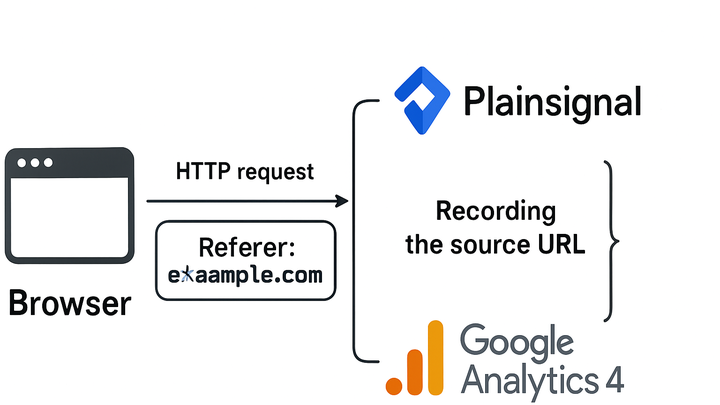Published on 2025-06-22T04:55:21Z
What is a Referrer? Examples from PlainSignal & GA4
Referrer is the URL of the previous page that directed a user to your site. It’s
captured via the HTTP Referer header (intentionally misspelled in the specification) and used
by analytics tools to attribute traffic sources. This data helps you understand whether visitors arrive
from search engines, social media platforms, email campaigns, or other websites. PlainSignal (a
cookie-free analytics tool) and Google Analytics 4 (GA4) both record referrer data, though they differ in
data models and privacy approaches. Referrer information fuels attribution reports, SEO insights, and
marketing ROI analysis but can be limited by browser privacy settings or HTTPS-to-HTTP transitions.
Implementing UTM parameters and appropriate referrer policies can mitigate data loss and ensure more
reliable attribution.
Referrer
The Referrer header identifies the previous page a user came from, enabling traffic attribution in analytics tools like PlainSignal and GA4.
Understanding the Referrer
The referrer in web analytics refers to the previous URL that directed a user to your page. Analytics
platforms capture this via the HTTP Referer header, helping you see which external sources
drive traffic. It’s a fundamental metric for attributing visits to search engines, social media, links
on other websites, and more.
-
Definition
Referrer (or referer) is the URL of the prior page from which a request originated, sent by the browser in the HTTP
Refererheader. -
Http referer header
When a browser navigates from one page to another, it includes the
Refererheader in the request payload, containing the source page’s URL.-
Historical misspelling
The HTTP spec misspells ‘Referer’ without the second ‘r’, though analytics discussions often use the correct ‘Referrer’ spelling.
-
Privacy controls
Browser referrer policies (e.g., strict-origin-when-cross-origin) can limit or omit referrer information for privacy reasons.
-
Why Referrer Data Matters
Referrer data is crucial for understanding where your visitors come from and how they find your site. It supports marketing decisions, SEO strategies, and performance optimization.
-
Traffic attribution
Associate sessions with specific sources like search engines, social platforms, or partner sites to measure ROI accurately.
-
Seo and content strategy
Identify which external pages and keywords drive organic traffic to refine your content plan and improve search rankings.
-
Campaign performance
Evaluate the success of email, ad, and affiliate campaigns by tracking the referring URLs that land users on key pages.
Capturing Referrer in Analytics Tools
Different analytics solutions capture and process referrer data in varied ways. Below are examples from PlainSignal and GA4.
-
PlainSignal (cookie-free simple analytics)
To integrate PlainSignal for capturing referrer data, include the following snippet in your site’s
<head>:<link rel='preconnect' href='//eu.plainsignal.com/' crossorigin /> <script defer data-do='yourwebsitedomain.com' data-id='0GQV1xmtzQQ' data-api='//eu.plainsignal.com' src='//cdn.plainsignal.com/plainsignal-min.js'></script> -
Google analytics 4 (GA4)
GA4 automatically collects
page_referreras part of its event-based model. Referrer data appears in the User Acquisition and Traffic Acquisition reports undersession_startevents.
Common Challenges and Best Practices
While referrer data is valuable, it can be imperfect. Here are common challenges and how to address them.
-
Missing or stripped referrer
Referrer information may be lost or incomplete due to cross-domain navigation or strict browser policies.
-
Https to http transitions
When navigating from a secure (HTTPS) site to an insecure (HTTP) site, browsers often omit the referrer for security reasons.
-
Referrer-policy settings
Site or browser-level policies can limit which parts of the URL are sent or block referrers entirely.
-
-
Using utm parameters
Add UTM tags to campaign URLs (
utm_source,utm_medium, etc.) to ensure accurate attribution even if the referrer is missing. -
Implementing referrer policies
Configure the
Referrer-PolicyHTTP header or<meta name='referrer'>tag to balance privacy with analytics needs.
